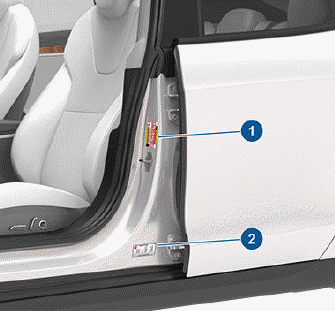Tesla Model S: Vehicle Labeling
It is important to understand your vehicle's original tire sizes and pressures, and the GVWR (Gross Vehicle Weight Rating) and GAWR (Gross Axle Weight Rating). This information can be found on two labels attached to Model S.

- Tire and Loading Information Label
- Vehicle Certification Label
WARNING: Overloading Model S has an adverse effect on braking and handling, which can compromise your safety or cause damage.
CAUTION: Never store large amounts of liquid in Model S. A significant spill can cause electrical components to malfunction.
Tire and Loading Information Label
The Tire and Loading Information label provides:
- The maximum number of occupant seating positions.
- The maximum vehicle capacity weight.
- The size of the original tires.
- The cold inflation pressures for the original front and rear tires. These pressures are recommended to optimize ride and handling characteristics.
United States/Canada:
.png)
Mexico:
Never change this label, even if you use different tires in the future.
NOTE: If Model S is loaded to its full capacity, double check all tires to ensure they are inflated to their recommended pressure levels.

.png)
